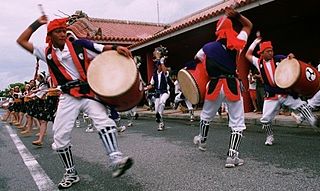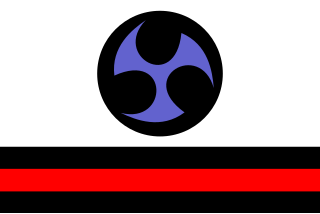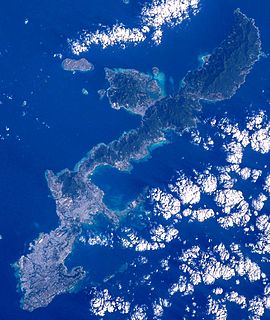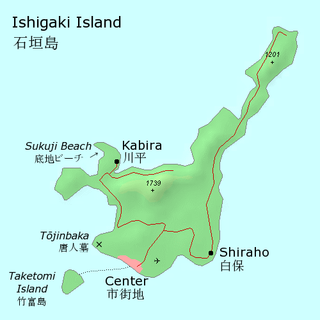
The Sakishima Islands are an archipelago located at the southernmost end of the Japanese Archipelago. They are part of the Ryukyu Islands and include the Miyako Islands and the Yaeyama Islands. The islands are administered as part of Okinawa Prefecture, Japan.

Gusuku often refers to castles or fortresses in the Ryukyu Islands that feature stone walls. However, the origin and essence of gusuku remain controversial. In the archaeology of Okinawa Prefecture, the Gusuku period refers to an archaeological epoch of the Okinawa Islands that follows the shell-mound period and precedes the Sanzan period, when most gusuku are thought to have been built. Many gusuku and related cultural remains on Okinawa Island have been listed by UNESCO as World Heritage Sites under the title Gusuku Sites and Related Properties of the Kingdom of Ryukyu.

Yaeyama is a district located in Okinawa Prefecture, Japan. The district covers all of the Yaeyama Islands except Ishigaki and the disputed Senkaku Islands.

The Japonic or Japanese-Ryukyuan language family includes the Japanese language spoken on the main islands of Japan as well as the Ryukyuan languages spoken in the Ryukyu Islands. The term Japonic languages was coined by Leon Serafim, and the family is widely accepted by linguists, unlike the controversial Altaic hypothesis. The common ancestral language is known as Proto-Japonic or Proto-Japanese-Ryukyuan. The essential feature of this classification is that the first split in the family resulted in the separation of all dialects of Japanese from all varieties of Ryukyuan. According to Shirō Hattori, this separation occurred during the Yamato period (250–710).
Okinawan music, also known as Ryukyuan music, is the music of the Okinawa Islands of southwestern Japan. In modern times, it may also refer to the musical traditions of Okinawa Prefecture, which also covers the Miyako and Yaeyama Islands, and sometimes the Amami Islands.
The Yaeyama language is a Southern Ryukyuan language spoken in the Yaeyama Islands, the southernmost inhabited island group in Japan, with a combined population of about 53,000. The Yaeyama Islands are situated in the Southern Ryukyu Islands, southwest of the Miyako Islands and to the east of Taiwan. Yaeyama (Yaimamunii) is most closely related to Miyako. The number of competent native speakers is not known; as a consequence of Japanese language policy which refers to the language as the Yaeyama dialect, reflected in the education system, people below the age of 60 tend to not use the language except in songs and rituals, and the younger generation exclusively uses Japanese as their first language. As compared to the Japanese kokugo, or Japanese national language, other Ryukyuan languages such as Okinawan and Amami have also been referred to as dialects of Japanese. Yaeyama is noted as having a comparatively lower "language vitality" among neighboring Ryukyuan languages.
The Yonaguni language is a Southern Ryukyuan language spoken by around 400 people on the island of Yonaguni, in the Ryukyu Islands, the westernmost of the chain lying just east of Taiwan. It is most closely related to Yaeyama. Due to the Japanese policy on languages, the language is not recognized by the government, which instead calls it the Yonaguni dialect. As classified by UNESCO, the Yonaguni language is the most endangered language in all of Japan.

New Ishigaki Airport,, also branded as Painushima Ishigaki Airport, is a regional airport located in the Shiraho district of Ishigaki, Okinawa Prefecture, Japan. The airport is located near the eastern coast of Ishigaki Island. It connects the island to major cities in Japan as well as destinations throughout Okinawa Prefecture and the Yaeyama Islands. New Ishigaki Airport was built to replace Ishigaki Airport, which with a shorter runway of only 1,500 metres (4,900 ft), could not accommodate larger jets.
Yukka nu hii is an annual festival of the Okinawa Islands of southwestern Japan, which is traditionally celebrated on the 4th day of the 5th month of the lunisolar calendar. It centers on the traditional dragon boat races. The festival dates back to circa 1400, where it is said to have been adopted from the Chinese. The dragon boat races are a form of giving thanks to the sea and agricultural gods and asking for their continued help for the future.

Yaeyama Subprefecture was a subprefecture of Okinawa Prefecture, Japan. It was abolished in March 2009. Most of its functions were taken over by the Yaeyama Office of the prefecture.
Shima-uta is a genre of songs originating from the Amami Islands, Kagoshima Prefecture of southwestern Japan. It became known nationwide in the 2000s with the success of young pop singers from Amami Ōshima such as Hajime Chitose and Atari Kōsuke.
Kaidā glyphs are a set of pictograms once used in the Yaeyama Islands of southwestern Japan. The word kaidā was taken from Yonaguni, and most studies on the pictographs focused on Yonaguni Island. However, there is evidence for their use in Yaeyama's other islands, most notably on Taketomi Island. They were used primarily for tax notices, thus were closely associated with the poll tax imposed on Yaeyama by Ryūkyū on Okinawa Island, which was in turn dominated by Satsuma Domain on Southern Kyushu.
Kamui ware (カムィ焼), from Tokunoshima kamïyaki, is grey stoneware produced in Tokunoshima, the Amami Islands, Kagoshima Prefecture, Japan from the 11th century to the early 14th century, or from the late Heian period to the Kamakura period.
Ryukyuan music, sometimes called Nanto music, is an umbrella term that encompasses diverse musical traditions of the Ryukyu Islands The term "Southern Islands" is preferred by Japanese scholars in this field. Unlike in the West, the Japanese notion of "Ryukyu" is associated with the former Ryukyu Kingdom based on Okinawa Island and its high culture practiced by the Yukatchu class in its capital of Shuri. By contrast, most scholars cover a much broader region and lay emphasis on folk culture.
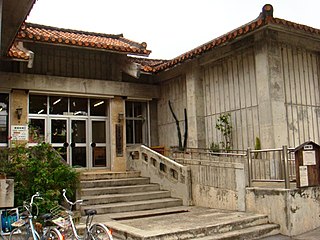
Ishigaki City Yaeyama Museum opened in 1972 in Ishigaki, Okinawa Prefecture, Japan. The collection covers the archaeology, history, art, and folk traditions of Ishigaki and the Yaeyama Islands.
Urasoe Ueekata Chōri, also known by Urasoe Jūri and his Chinese style name Shō Kakusen, was a bureaucrat of the Ryukyu Kingdom.



